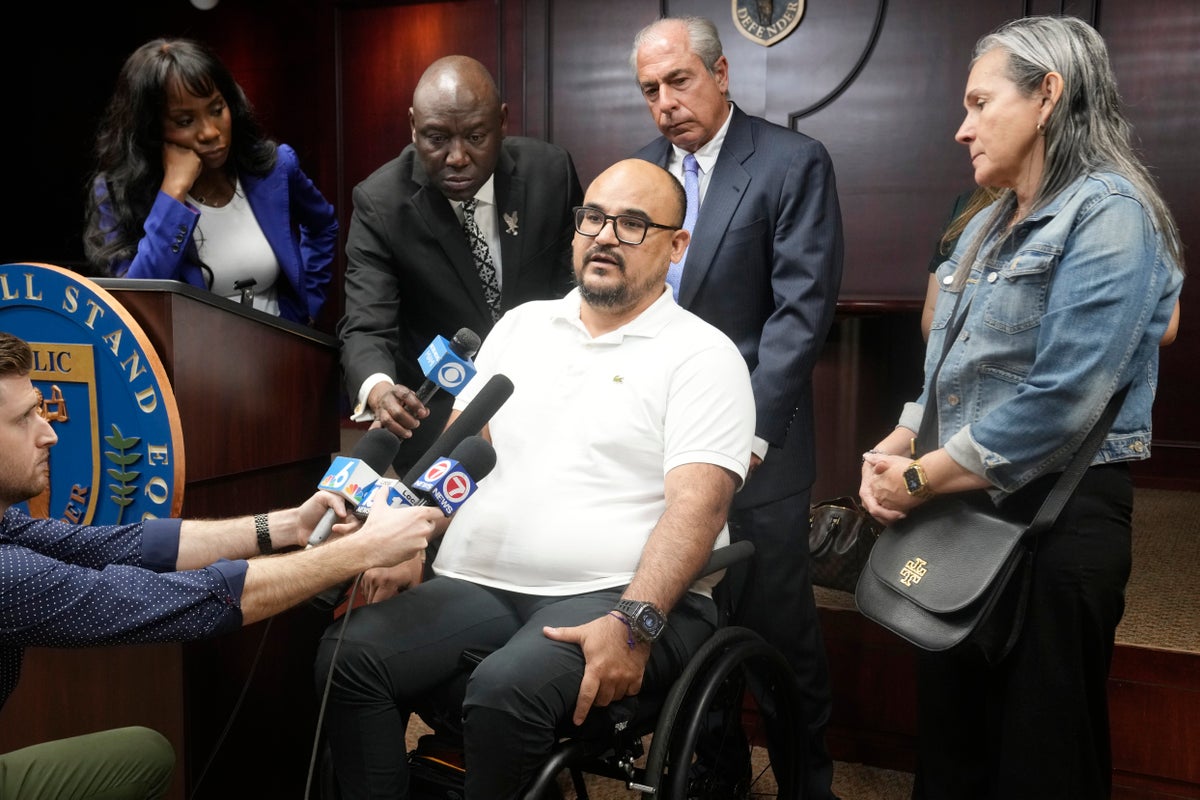
A Florida man left paralyzed when a police officer shot him after mistaking his handgun for his stun gun filed a lawsuit Wednesday against the city, the officer and others, saying, “my life got destroyed.”
Michael Ortiz is seeking unspecified millions of dollars from the city of Hollywood, Florida, and Officer Henry Andrews, 50, who is also facing a misdemeanor charge for the 2021 shooting — one of several over the last 20 years where officers say they mistook their gun for their Taser. The federal civil rights lawsuit also names officers Dionte Roots and Jhonny Jimenez, who were subduing Ortiz when Andrews shot him.
Ortiz, speaking at a press conference, said not only has his own life been destroyed, but so has his mother's as she has to change his diapers and provide other care. He had called 911 for help while suffering from a mental health crisis before he was shot while handcuffed on the ground.
“She is treating me like I am 6 months old,” said Ortiz, 43, who is paralyzed from the chest down and uses a wheelchair. He owes $3 million in medical costs and will need lifetime care.
Florida-based civil rights attorney Ben Crump, who is representing Ortiz along with attorney Hunter Shkolnik, said it's an “injustice” that Andrews has been charged with only a misdemeanor.
“Michael Ortiz needed a helping hand and what he got was a bullet to the back,” Crump said. Crump represents many victims nationwide of alleged police misconduct, including the families of Michael Brown, Breonna Taylor and George Floyd. “There should have been greater accountability for the officer."
Hollywood officials declined comment. Attorney Jeremy Kroll, who represents Andrews in the misdemeanor culpable negligence case, said another lawyer will be hired to represent the officer in the lawsuit.
“In responding to a difficult and chaotic situation, Officer Andrews intended to deploy his taser and mistakenly discharged his firearm. There was absolutely no intent to harm in this case. He and his family continue to have Mr. Ortiz in their thoughts and prayers,” Kroll said in a statement.
It could not be determined if Roots and Jimenez have attorneys who could comment. They have not been charged criminally.
Ortiz called 911 on July 3, 2021, telling operators he was experiencing a mental health crisis while house-sitting his mother's apartment and his dog was missing. He told them he had used marijuana and was having chest pains; the operators noted that he sounded delusional and suicidal.
Ortiz then took a shower to calm down. When paramedics arrived, he refused to come outside so they called for police assistance. Paramedics say he then came into the hallway nude and became combative, threatening suicide. They say they were stopping him from jumping from a sixth-floor balcony when Roots and Jimenez arrived.
Security video of the shooting has not been released publicly, but the city has shown it to Shkolnik.
He said Roots used his Taser to subdue Ortiz, who was then handcuffed behind his back and placed naked on the floor just outside the elevator. He was still struggling, but was not posing any danger to himself or the officers if they had just moved back and let him calm down, Shkolnik said.
The elevator opened and Andrews stepped out. Roots tried to use his Taser on Ortiz again, but it didn't discharge.
In a court filing in his misdemeanor case, Andrews, an officer for more than two decades, said he reached for his Taser but instead grabbed his gun, firing one shot into Ortiz's back. That happened about 10 seconds after the elevator door opened, Shkolnik said.
“I genuinely believed I had grabbed and was discharging my taser,” Andrews wrote.
Andrews’ Taser, like most, was shaped like a handgun and had a similar grip and trigger, but it was also bright yellow instead of black — a detail that is supposed to serve as a visual warning to the officer in the heat of the moment.
To further avoid mix-ups, officers are trained to keep their firearm on their strong side and their stun gun on the opposite hip. Andrews also did that.
Kroll said in that filing that while Andrews' conduct may have been civilly negligent, it wasn't criminal and asked that the charge be dismissed. The judge has not ruled.
While extremely rare, there have been other cases nationally where officers say they mistook their gun for their stun gun and accidentally shot a suspect, sometimes fatally. Criminal charges are sometimes pursued, but not typically as officers have broad immunity when dealing with potentially dangerous suspects.
In 2021, a Minnesota police officer was found guilty of manslaughter in such a case. That also happened after a 2015 shooting in Oklahoma. In 2009, a fatal shooting at an Oakland, California, transit station led to the 2013 movie “Fruitvale Station.” That officer was found guilty of involuntary manslaughter.







